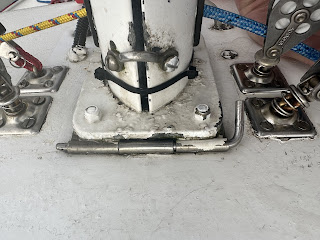Waterline Discoveries
When I bought the boat it had a good buildup of bottom paint. The paint was flaking off in places and was obviously deep. I was told it was Pettit Trinidad, a hard anti fouling paint. The topside red paint was fairly faded with lots of experience points here and there.
I took the bottom paint off with a Festool Rotax sander/grinder connected to a vacuum. The factory gel coat is black! I found through a history search on the boat hull number that it was originally a San Diego boat named Vamp. That makes sense, a Goth boat.
There was evidence of some minor blister repairs. I found several small 1-2mm blisters which I treated. I also faired out any uneven spots or scrape marks with thickened epoxy.
The pics above show the difference between the factory waterline and the one the previous owners painted on. Apparently the factory waterline assumes there is a person or two in the cockpit. Let’s call that the “underway” waterline. This assumes the boat will be dry sailed. For those of us unable to dry sail we will need to apply bottom paint and cover the factory waterline and then some.
The seam between the keel and hull was a little work. I first cleaned it out. There were a few layers or patches of some kind of rubbery sealant which I pulled and cut out. I replaced it with 5200 applied in two sessions.
The boat had two thru-hulls for a sonar transducer and a boat speed sensor. One of the thru-hulls on the starboard side was a little too close to the keel for me. I ground it out to a wide bevel inside and out and then filled it with around 8 layers of fiberglass fabric patches and epoxy. Faired that out and now it is no longer visible. I cut out the other transducer sleeve and replaced it with an Airmar DST810. That is an NMEA 2000 sensor for depth (sonar), boat speed and water temperature.
After all that I applied two coats of Pettit eProtect epoxy primer and barrier coat. This seals the old polyester resin gel coat to prevent future blisters. It also gives a good base for the bottom paint to adhere to. Bottom paint is ePaint EP-2000. It is an eco-friendly anti-fouling paint that gives off hydrogen peroxide when exposed to sunlight. Of their various colors they suggest white for the best anti-fouling performance. They call it eco-friendly because it doesn’t contain heavy metals like copper and it doesn’t have the super nasty chemicals. It is water based which was very nice while painting it on. No horrible fumes so no need to wear a respirator.
Above the waterline I didn’t go down to gel coat everywhere. I made a few repairs, especially on the transom. I wanted a nice, clean transom. I also removed a few layers of a high white stripe and decided to leave the stripe off. After much sanding, filling and fairing I put on two coats of Awlgrip primer (gray). Followed that up with two coats of topcoat Awlgrip (Rochelle red on the sides and bright white on the transom and rail.
Previous paint was Awlgrip so I replaced it with that. New Rochelle Red. Tip and Roll method on topside coats (2x). Don’t bother with tip and roll on primer.









Comments
Post a Comment